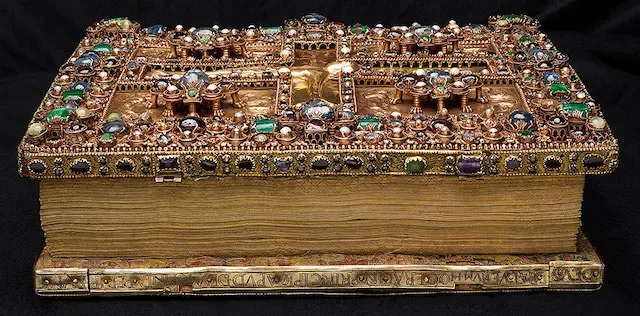The Ancient Art of the Bedazzled Book Cover

As a form of technology, the book has evolved in numerous ways since the conception of writing systems in estimated 6000 B.C.E. What we know now as physical books and ebooks, came from humble beginnings, including tablets, scrolls, leaves, and leather. The book cover started out completely functional in nature, to protect the pages. According to The Book: The Life Story of a Technology, wooden boards were used as makeshift covers, hence the word “hardcover.” The creation of moveable type and the printing press led the way for the mass production of books. While cloth binding was common, the hand-binding of books became an art, especially in countries such as England and France. This period became known as “The Renaissance of bookbinding.” Some of the books created during this time were intended to be looked at, rather than read. The creation of the bedazzled book cover was an art form, requiring ample time, steady hands, and a variety of precious materials. Read on to learn more about the ancient art of the bedazzled book cover.
Bookbinding as an Art
The interest of bookbinding as an art came about with the progression in technology related to the mass production of books. According to The Art Amateur from 1884, “The invention of printing caused an immediate fall in the rarity and value of books, which then became simply instruments of knowledge or of pleasure.” What was once a unique item, the book, as enjoyed by scholars and wealthier individuals, became more commonplace, thus changing its value and uniqueness. Something was needed to differentiate one book from another, to set the bar higher than what was being mass-produced, if you will.
Enter the Bedazzled Book
Although there had been a number of highly decorated books created prior to this time, the majority of these were religious in nature. As books continued to be produced in a higher volume, the binding became the perfect canvas for artistic creation. According to one source written during this time, the book’s cover was thought of as being either two things, “An element in interior decorating, or as clothing.” In this school of thought, books were thought of as requiring the same respect as a person, to be dressed. They were also considered an artistic item to put on display, such as in the living room of one’s home.

In regards to the famed Kelmscott Chaucer book, the binder William Dana Orcutt said, “After all, a book is made to be read, and the Kelmscott Chaucer is made to be looked at.” But, this particular book had more to study than just it’s cover. The pages were also created with an artistic flair, showcasing intricate illustrations and designs on the pages.
Books during this time were designed with a variety of materials. The binding, including the cover, was sometimes made from different leathers (both polished and unpolished), metal, ivory, fabrics, gold gilding, and enamels.
Some of the oldest decorated books were on display in New York at The Morgan Library and Museum, from the end of 2017 to 2018. One of these included the jewel encrusted Lindau Gospels, which was created in the ninth century. To refer to this book as being bedazzled is an understatement. According to The Morgan Library and Museum’s website, books such as this are considered to be treasure bindings. Meaning the book’s binding is a serious treasure to behold, having been artistically created with a variety of jewels and fine materials, including gold. The book cover evolved from being purely functional, into fine art and a method of advertisement.

The Bookbinder as an Artist
In Artistic Book Binding, the bookbinder is looked at as a creative and that, “The modern bookbinder has become an artist like the painter, the architect, and the musician, and those who excel in their art have pupils, a studio, a manner of their own. They have their secrets, and their signature is paid for in gold like that of the painters a la mode, and like the painters they have their jealousies, their rivalries, their vogue and their decadence.” Hand-bound books of this decorative magnitude could not be mass-produced, and were expensive, being sold through booksellers rather than to the public forthright.

Bookbinding Today
The art of the hand-bound book continues into today’s modern world. Those interested in this craft can either enroll in programs at various educational institutes, study under binding masters in an apprenticeship program, or both. These modern-day binders do more than create new hand-bound books; they fix the bindings of the antique style books we’ve previously discussed. The Renaissance of Bookbinding, though a short time period, remains an essential aspect of history when considering the book as a technology. This time period continues to provide the bibliophile with proof that you could judge a book by it’s cover. The book, regardless of the knowledge it held, was itself a piece of art. Just as a painting created by Picasso, the books mentioned in this post were made for display. To some, the book was an embodiment of man, and as such were to be treated as so. This included allowing the book to dress the part. As stated by Theodore Child, “Books are our wisest counsellors, our safest guides, our truest friends; we surely ought to know how to dress them.”
Sources:
https://bookbindersmuseum.org/the-private-press-movement-in-britain-and-america/
Howard, N.(2009). The Book: The Life Story of a Technology. Baltimore, Maryland. The Johns Hopkins University Press.